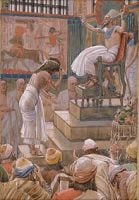
The Fertility of Letters
When G‑d promises great wealth to Abram, after Abram refuses the spoils of war offered by the King of Sodom, Abram retorts: What can You

When G‑d promises great wealth to Abram, after Abram refuses the spoils of war offered by the King of Sodom, Abram retorts: What can You

Now as I beheld the Chayot [living creatures], behold one Ophan [wheel] at the bottom hard by the living creatures, at the four faces thereof. The

The confrontation between Joseph and his brothers is one of the most troubling stories of the Bible. Joseph and his brother—twelve sons of Jacob—were the

As we discussed in the previous post “Singularity and Paradise,” Paradise offers a beautiful metaphor for modern cosmology wherein Eden is the initial singularity preceding

These are the chronicles of the heaven and of the earth when they were created, in the day that the Eternal G‑d made earth and

Meditations on the Maaseh Merkavah – IV This is the fourth and the final installment in the series of posts related to Ezekiel’s prophesy, Ma’aseh

And ye shall take you on the first day the fruit of goodly trees, branches of palm-trees, and boughs of thick trees, and willows of

In the six hundredth year of Noah’s life, in the second month, on the seventeenth day of the month… all the fountains of the great

Now, therefore, write ye this song for you, and teach thou it the children of Israel.” (Deut. 31:19) The four known fundamental forces are: gravitational

This week, we read in the Torah portion Vayigash (Gen. 44:18–47:27) about Joseph revealing himself to his brothers and Jacob coming to Egypt with his family. This
On Seder night we drink four cups of wine and eat three matzoth. Why four cups and not three? Why three matzoth and not four?
The holiday of Passover – Pesach – is called zman cheruteinu– time of our freedom. As we have discussed many times on this blog (see
This Rosh HaShanah I had the strangest dream. I dreamed that I was giving a lecture in cosmology at a university when I suddenly realized